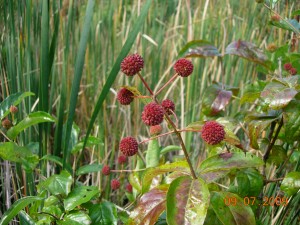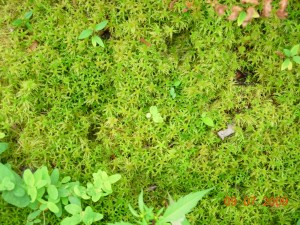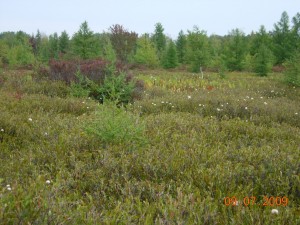Mid-morning I looked out the window and saw a small bird in the shrubs, moving about pretty actively. It was an American Redstart, not in the black and orange adult male plumage, but rather the olive-backed, gray-headed plumage with yellow wing and tail patches that at this time of year could be a female or a young male.
We had no breeding redstarts in the vicinity this summer, so this was most likely a migrant. Perhaps Katy and I would have done to well stay home and see what else had arrived, but today was a holiday, hence worth a small excursion.

Marsh east of Westnedge Avenue at West Lake Bog . Photo by Richard Brewer
We drove to the West Lake Preserve in Portage. It has trails, including boardwalks (of green plastic) that run out into marshes east of Westnedge Avenue. The marshes have some cat-tails but are mostly sedges plus a great variety of other herbs and a few shrubs.
Button-bush is the most common large shrub. It’s distinctive, easily identified with its whitish ball-like inflorescence in summer which remains ball-like in fruit but turns a rosy color. Easily identified, as I said, as long as you find it in wet ground and it has flowers or fruits.

Button-bush in fruit in marsh at West Lake. Photo by Richard Brewer.
Once at the Michigan Nature Association’s Black River Sanctuary near Breedsville, the sanctuary steward showed me a large shrub or small tree on dry ground–though not far from the river. It had no flowers or fruits and puzzled both of us for a while. Having finally identified it, I think I’ll know it in the future even if it has no flowers or fruits. The fact that it has neither alternate or opposite leaves but instead often has three at a node is a quick first clue.
We were hoping for migrating warblers and other small birds, but the first birds we heard were two Sandhill Cranes. They were coming from the south and we heard the rolling rattle they make while flying a minute or so before they came in sight over the trees behind us. They might have been planning to land in the large patch of marsh through which the boardwalk runs if we hadn’t been there.
As it was, they flapped a little harder, regained altitude, passed over a line of trees and came down out of sight ahead of us. Not long afterward, a Great Blue Heron, another big bird though not as big as the crane, flew in from the east. It did park in the patch of marsh we were passing through, but out of sight in a strip of water on the far side.
It turned out that we saw and heard only a few song birds. The birds that bred here this year are mostly quiet, some still completing their fall molts. A few Red-winged Blackbirds were still noticeable in the marshes. The largest concentration of birds we saw was in a black gum tree. Its leaves were already red and the ripe dark blue fruits were being visited by a good many largish songbirds. We saw Blue Jays and catbirds, but may have missed other species.
Relatively undisturbed wetlands are always interesting botanically. There are often a lot of species, and some are in groups that present some identification difficulties. But the set of species that can handle really wet ground and especially standing water is circumscribed. You don’t have to look through the whole plant manual to identify hydrophytes; instead you can pretty much confine your search to the specialized books on aquatics.
I don’t know what the best such manuals are today. I still have a copy of Norman Fassett’s A Manual of Aquatic Plants from 1957 and it serves the purpose. A little updating of scientific names may be necessary, but that could be true if you use a manual published six months ago.
Several plants were blooming in the marshes. In fact, flowering late in the season characterizes the wetland flora. Among plants in flower were pickerel-weed with blue flowers, white-flowered arrowheads, and yellow-flowered bur-marigolds.
The water level was lower than we had seen in recent years, when it had come up to or over the flexible boardwalks. Bladderworts were growing and flowering on the exposed peaty surface alongside the boardwalks. They were tiny plants. Some species of bladderworts have purple flowers and some yellow. These plants had tiny bright yellow flowers. I thought they might be Utricularia gibba, but I wasn’t in a serious plant-identifying mood today.

A blanket of sphagnum moss in West Lake Bog. Photo by Richard Brewer
We continued to where the boardwalk loops back to the dirt path and followed that to the boardwalk that runs out into the sphagnum bog fringing West Lake. The flora of bogs is even smaller and more specialized than most other wetlands, but includes many striking and beautiful species that can be seen in no other habitat. The West Lake boardwalk is probably the best local opportunity to see this community with such things as tamarack, leatherleaf, cottongrass, pitcher plant, and sundew.
After the bog, we hiked back out to the parking lot. It was 12:30 and we had plans to continue our holiday with lunch at the Lebanese buffet.

Tamarack bog with leatherleaf and cottongrass. Photo by Richard Brewer